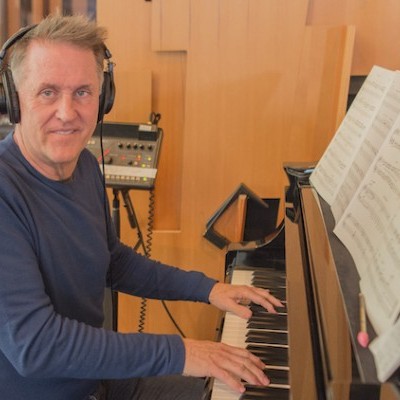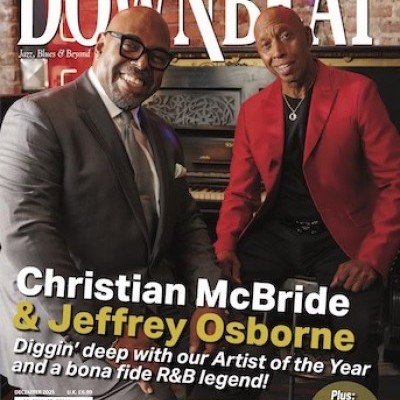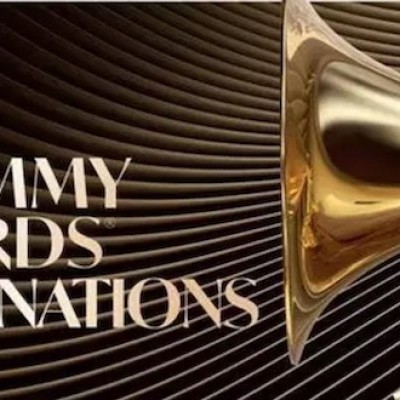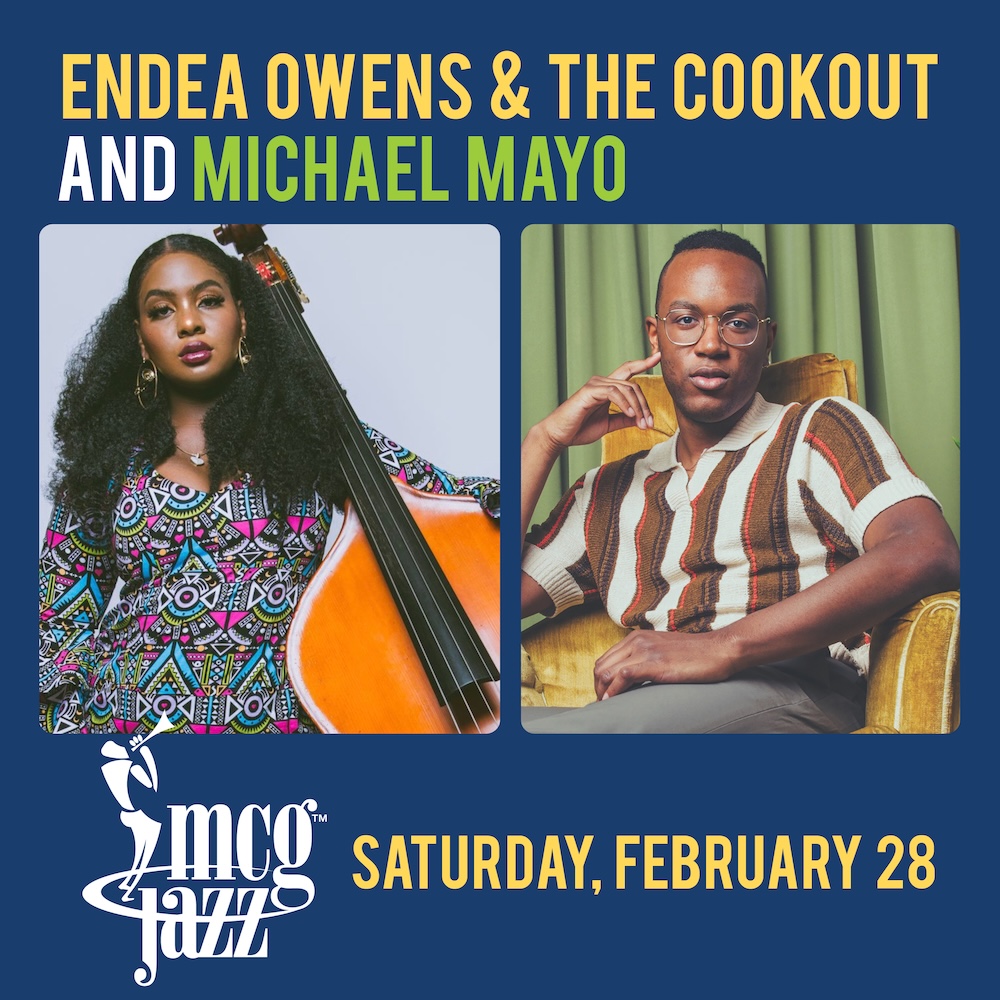Oct 28, 2025 10:47 AM
In Memoriam: Jack DeJohnette, 1942–2025
Jack DeJohnette, a bold and resourceful drummer and NEA Jazz Master who forged a unique vocabulary on the kit over his…

The Jazz at Lincoln Center Orchestra’s trumpet section, from left, Wynton Marsalis (JALC managing and artistic director), Ryan Kisor, Kenny Rampton and Marcus Printup.
(Photo: Gilberto Tadday)“People are still swinging in the United States of America!” With those telling words, Wynton Marsalis closed the first of two concerts that, on consecutive June nights, brought to a rousing and defiant end the 20th season of Rose Theater — the most jazz-centric concert hall in New York.
Declaiming from a top-tier seat on an onstage platform — his chair, that is, in the trumpet section of the Jazz at Lincoln Center Orchestra — Marsalis, who in addition to his playing role is JALC managing and artistic director, delivered his message with the authority of an exalted member-cum-leader of the band.
Even before the October 2004 opening of the theater and its sister stages, the Appel (then Allen) Room and Dizzy’s Club — a landmark event that gave Lincoln Center jazz a brick-and-mortar home on par with those of the center’s other performing arts — Marsalis enjoyed the status of a singular cultural figure.
Then, as now, he has deployed the attendant power strategically, by turns absorbing and repelling the slings and arrows that come with occupying the most visible leadership position in a fractious field of artistic endeavor. But he has also been remarkably resolute in maintaining his programming vision.
And what, in essence, is that vision?
“Actual jazz,” he asserted during a March interview. “Swinging, playing the blues, being able to improvise on changes and form: actual jazz music. That’s the genre we need to concentrate on.”
While Marsalis offers a view of an art form whose definition is eternally up for debate, his achievement is not. As the Frederick P. Rose Hall’s three stages enter their third decade — and the jazz project at Lincoln Center nears its fifth — the institution remains vibrant and prepared to take on the future, even at a time when the slings and arrows are coming from new directions.
For evidence of the institution’s vibrancy — and of the Marsalis programming philosophy in action — one need look no further than that June concert. Playing to a packed house, the concert, tagged with the deceptively banal banner Best of the JLCO, was a stylistic smorgasbord that, for all its diversity, had the crowd’s heads bobbing in unison.
The offerings impressed, from the opening tune, a piquant mambo-and-guajira-traversing “Two-Three’s Adventure” by the prolific JLCO bassist Carlos Henriquez, to the closer, JLCO trombonist Vincent Gardner’s delectably disorienting “Up From Down.” Equally impressive was the sense of thematic unity, each of the 11 numbers on the program serving up a distinct but authentic flavor of swing.
When in the middle of the program Gardner suddenly appeared as vocalist, on JLCO saxophonist Sherman Irby’s sly throwback of a take on the century-old “Yes, Sir, That’s My Baby,” the contrast with the fiercely contemporary material surrounding it only highlighted swing’s range of expression. That the arrangement was cooked up casually and was now a durable part of the JLCO book was no surprise, according to Gardner.
“We have so much faith in just what the music is about that you can do things on the fly,” he said in a post-concert Zoom interview. “Anything within the jazz context has a chance to be appealing to anybody at any time.”
Broad appeal is a factor in programming artists at a 1,200-seat theater like the Rose. But even with an exceptional donor base — and guest musicians occasionally willing to work for a reduced fee, according to Marsalis — merely filling seats is not enough to keep the boat afloat.
“We pretty much have always had a break-even budget,” Marsalis said. “We have to work, we have to make money, we have to raise money — what all institutions do and should have to do.”
As an independent corporation within Lincoln Center for the Performing Arts, JALC, according to Lincoln Center VP of programming Jordana Leigh, must raise the “very big bulk” of its own funds. So architects designed a theater space flexible enough to attract non-jazz events and generate revenue from them. An adjustable orchestra pit and multiple onstage seating towers, for example, allow seating to be added or reconfigured depending on an organization’s needs.
The theater’s relative intimacy facilitates the performance of jazz but also of other types of presentations; no seat in the house is more than 90 feet from the stage. More salient to jazz audiences may be the acoustical feature that affords the bass unusual clarity.
Of course, the most jazz-friendly aspect of the theater remains the roster of artists, and it casts a surprisingly wide net. Some are even outside the jazz orbit. But no matter where artists come from, they will, once committed to rehearsing and performing with the JLCO, be meeting jazz more than halfway — consenting, in effect, to a merging of styles that consists of an orchestra member writing a jazz arrangement of his music, according to Jason Olaine, JALC vice president of programming.
“In an ideal sense,” Olaine said as he sat in a Rose Theater dressing room on a June afternoon, “it’s not jazz reaching out to other genres but other genres coming to jazz.”
JLCO trumpeter Marcus Printup, standing outside the JALC West 60th Street stage door during a break one mild day in July, recalled a 2011 gig in which Eric Clapton was collaborating on a show with an ensemble drawn from players inside and outside the orchestra. The guitar king of swinging ’60s London, Printup said, had admitted, during the days of pre-concert preparation, to being “nervous.”
But once Clapton and the band launched into his “Layla,” any jitters seemed to subside. While Marsalis’ arrangement bore little resemblance to Clapton’s standard hard-driving rendition — it opened cacophonously before yielding to a steamy dirge straight out of New Orleans — it gave a jazz voice to Clapton’s blues-tinged theme of unrequited love, and he adjusted seamlessly.
Another classic-rock guitarist, Steve Miller, has developed an ongoing relationship with JALC. Introduced to Marsalis by Olaine, who engaged him in conversation after spying him in the Dizzy’s audience, Miller has since taken the Rose stage at least six times. Though specializing in the blues — Miller is developing a course on the subject for JALC — he is scheduled for a November concert celebrating Eddie Harris and Chico Hamilton. He has grown so tight with JALC officials that he now sits on the Board of Trustees.
That development has sparked interest but hardly eclipsed the buzz created when, in a 2006–07 season otherwise marked by an affirmation of the JALC identity — it retired the “Lincoln Center Jazz Orchestra” moniker — avant-garde icons Cecil Taylor and John Zorn crashed the House of Swing in a double bill and, on another night, Joe Zawinul, in a concert titled Fusion Revolution, rocked the bank of synthesizers he famously used to great effect with Weather Report.
This year, Weather Report material surfaced in a May concert, titled JLCO Plays the ’70s, that included Zawinul’s hit “Birdland.” Arranged by JLCO trombonist Chris Crenshaw, the newly expanded version deepened the already rich palette of the original and, powered by Irby’s eerie evocation of Wayne Shorter’s soaring soprano saxophone, recalled its electrifying sound and feel.
Similarly charged programming has intermittently popped up in the smaller venues. In the Appel (then Allen) Room — whose steep, flexible seating of up to 500 and panoramic view of Manhattan invite audaciousness — an interactive presentation in 2013 featured the Sun Ra Arkestra complete with real-time digital projections and cartwheeling acrobats. Olaine likened it to a “three-ring circus.”
Six years later, trumpeter Wadada Leo Smith brought to the room his suite America’s National Parks — a sprawling work that might not have met the letter of Marsalis’ “actual jazz” (Smith once told this writer, with little apparent irony, that he “never played a change”) but, in its searing impression of the American landscape, captured the yearning for freedom inherent in the spirit of jazz.
This past June, in the 140-seat Dizzy’s, Immanuel Wilkins went even further afield with his striking new suite for saxophone and string quartet, Ethnic Cleansing–An American Tradition. Chatting before the performance, the alto player noted that the work, a collaboration with Poland’s Lutoslawski Quartet conceived in the mode of 12-tone classical composition, was a risk for both him and the venue.
“It’s going to be interesting how it lands,” he said as he busily organized the extensive score on his music stand. He need not have worried; the music landed well, though, apart from an improvised cadenza of Wilkins’ that had the logical development if not the fully syncopated rhythm for which he is known, it fell outside even the broadest definition of jazz performance.
Such presentations are infrequent enough to qualify as exceptions. And while they certainly lend credence to Olaine’s argument that “we’re less quote-unquote conservative than people think we are,” some exceptions, he acknowledged, could be a bridge too far: “Maybe we’re not going to see the blend of hip-hop or neo-soul with jazz.”
Whatever the programming limits, he ventured, “Jazz at Lincoln Center is presenting a lot of diversity within the jazz canon.” In the realm of trumpeters alone, the programming routinely mines a long lineage of players, from Louis Armstrong to Roy Eldridge to Dizzy Gillespie, Miles Davis and, well, plenty of Marsalis.
But arguably no one better embodies the JALC ethos than pianist Bill Charlap, whose choice was a “no brainer” when, in 2004, the organization was seeking the person to open Dizzy’s, said Roland Chassagne, the club’s general manager and a member of the team that, 25 years ago, developed the JALC complex.
Nursing a glass of water in Dizzy’s on a June afternoon, Chassagne elaborated: “I will sum up Bill Charlap in two words — unapologetic swing. He swings so hard and he’s so dedicated to jazz music and swing in general on a spiritual level that it made tremendous sense.”
Charlap, who was honored at the JALC gala in 2024, has since that festive opening day directed at least seven shows for JALC. The shows, on all three stages, have explored subjects ranging from the birth of the cool to great American songwriters.
As far as it goes, Chassagne’s Charlap profile is accurate. But, along with his hard swing and faithfulness to form, Charlap’s choice of interpretive devices and the spontaneity with which he employs them at the piano can be as breathtakingly radical as, say, Taylor. He thus seems predisposed toward skepticism about siloing in the jazz community.
“It’s silly it should get so fractious because ultimately it’s not like that,” he said in a phone interview. “I really don’t think that the factions are so divided as people think — not within the family of musicians.”
Silly or not, a certain self-segregation persists, with more-overtly “experimental” players and their audiences often gravitating toward venues that, compared with those of JALC, are less opulent and more dedicated to their styles.
For others, though, JALC is, as younger musicians in the band call it, “the fort”: a guardian of classic works, yes, but also a conduit for new ones, some so distinctive they become part of the canon. Darcy James Argue’s hyperkinetic dance number “Single-Cell Jitterbug,” performed at a JLCO concert in April confidently titled Contemporary Jazz Masterpieces, may be one.
In a few cases, canonization can co-exist with subversion of at least some elements of “actual jazz.” Ornette Coleman, who upended harmonic orthodoxy, nonetheless donned a hard hat and, like Charlap and Tony Bennett, was invited for a rare tour of the JALC complex while it was being built. He was inducted into the JALC’s Ertegun Jazz Hall of Fame in 2008, played a greatest-hits set at Rose Theater in 2009 and received a JLCO retrospective in 2018.
“I would consider him a mainstream artist for us,” Chassagne said, “just because of his commitment to jazz music his entire life.”
As the canon grows and morphs, so does the JALC brand. And as it does, collaborations with other Lincoln Center arts groups have perhaps become less urgent, if no less of an occasion. (Details of a major one being planned are, as of this writing, embargoed.)
Precisely what all that portends for JALC programming is an open question. Looking beyond his tenure, the 63-year-old Marsalis noted: “It’s going to be up to the younger musicians now to determine that. They’re going to define what it is going into the future, and how they choose to deal with it in the halls.”
One musician he looked to was 25-year-old drummer Domo Branch. A JLCO sub, Marsalis small-group sideman and community activist, Branch has joined the JALC artist advisory council and written an essay in the organization’s 2024 annual report. In it, he identified a “new dimension for jazz,” which, in a July interview, he clarified as a post-pandemic, post-George Floyd generational shift from “singing about love” to reflecting “a lot of pain.”
“Jazz at Lincoln Center,” he said, “has an opportunity to truly show their integrity, an opportunity to truly show what they are about. In these times, you have to show that you don’t bend and break.”
If in these times democracy is bending under pressure, it is, in JALC corridors, unbroken. A Rose Theater rehearsal the day before the JLCO’s first-ever late-July concert, Reflections on Africa, proved a model of democratic process as Irby, front and center in the saxophone section, waved a hand to lead the band through the lush opening of Randy Weston’s “Bantu.” Trombonist-tubist Gardner, the concert’s designated music director, refereed the ample give-and-take. And bassist Henriquez offered supportive commentary paralleling his role as musical anchor.
The rehearsal offered a glimpse of how the band might function post-Marsalis, as well as of the upcoming season, themed Mother Africa. “Bantu” was heavily invested in authentic African grooves supplied by guest percussionists Iyedun Ince and Chief Baba Neil Clarke (who played with Weston). But in the melding of those grooves with the jazz influences in the Melba Liston chart, more than a hint of Marsalis lingered.
Henriquez, chatting during a rehearsal break, noted the leader’s impact. While Marsalis’ “musical ideology can be subjective,” Henriquez said, his single-minded codification of the jazz classics had helped cement their standing among the wider public. And he had done so against the run of play.
“Everybody’s trying to push the envelope,” Henriquez said. “He’s trying to do the preservation, which is the hardest part.”
In fact, Marsalis’ preservationist instinct and provocative pen have combined to push against cultural amnesia and create something new. From his Blood On The Fields to The Ever Fonky Lowdown, he has over the past 30 years drawn a direct line from works like Duke Ellington’s Black, Brown And Beige: fashioning the most potent critiques from the stuff of swing and expanding its scope.
He has also beat the system in a business sense, marshalling an improbably diverse set of New York players and driving to unlikely completion — from concert series to co-equal constituent of Lincoln Center — a visionary jazz institution.
Speaking by phone, Bob Mintzer, chief conductor of Germany’s WDR Big Band, praised the JLCO for its sound, to be sure, but also for its organization: one, common in Europe but lacking stateside, in which a jazz orchestra functions like a symphony orchestra, with a season and a steady job for all its musicians.
“Great things can happen when you have that situation,” he said.
Great things have happened, but Marsalis takes it all in stride.
“For us,” he said, “it was a public service.” DB

Jack DeJohnette boasted a musical resume that was as long as it was fearsome.
Oct 28, 2025 10:47 AM
Jack DeJohnette, a bold and resourceful drummer and NEA Jazz Master who forged a unique vocabulary on the kit over his…

Goodwin was one of the most acclaimed, successful and influential jazz musicians of his generation.
Dec 9, 2025 12:28 PM
Gordon Goodwin, an award-winning saxophonist, pianist, bandleader, composer and arranger, died Dec. 8 in Los Angeles.…

Nov 13, 2025 10:00 AM
For results of DownBeat’s 90th Annual Readers Poll, complete with feature articles from our December 2025 issue,…

Flea has returned to his first instrument — the trumpet — and assembled a dream band of jazz musicians to record a new album.
Dec 2, 2025 2:01 AM
After a nearly five-decade career as one of his generation’s defining rock bassists, Flea has returned to his first…

To see the complete list of nominations for the 2026 Grammy Awards, go to grammy.com.
Nov 11, 2025 12:35 PM
The nominations for the 2026 Grammy Awards are in, with plenty to smile about for the worlds of jazz, blues and beyond.…








